Will Doves Come Back to Nest After Being Scared Off
Every editorial product is independently selected, though we may be compensated or receive an affiliate commission if you buy something through our links. Ratings and prices are accurate and items are in stock as of time of publication.
Mournings doves are beloved in backyards across America. Learn interesting facts you should know about the beautiful mourning dove.
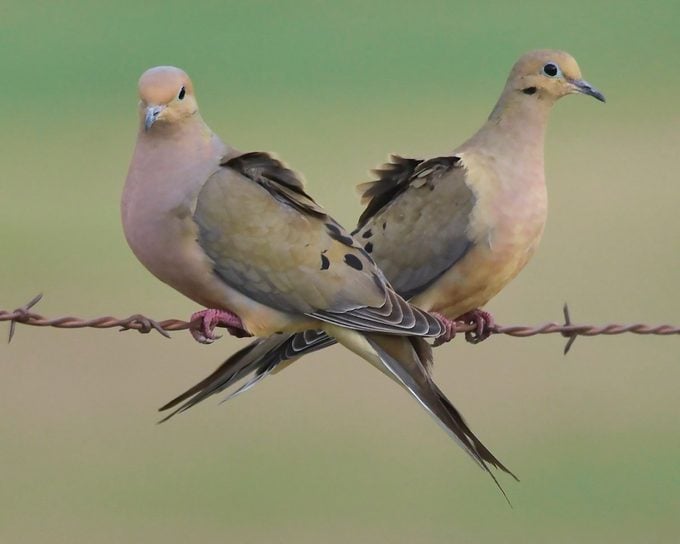 Courtesy Teresa Taylor
Courtesy Teresa Taylor
I already knew that mourning doves will sometimes hang around our cold, snowy Northeast winters rather than migrate, if there is food—that is, if we keep our bird feeders stocked. My thoughts turned to this as I watched from the window as a pair of them scooped up some spillage off the ground below one of our backyard feeders. They're still here, and I resolved to to keep the feeders full and help them stay around. I find their cooing sound comforting. Here are some interesting facts about the mourning dove, which may enhance your appreciation of this bird, too.
What Do Mourning Doves Eat?
Mourning doves are primarily seed-eaters, not insect-eaters. These birds can and do eat weed seeds, which is certainly valuable to gardeners as well as farmers, or anyone living near overgrown vacant lots. (They do like corn, though.) These doves evolved specifically for ground foraging, eating up to 20% of their body weight in seeds daily.
The Best Mourning Dove Feeders
To attract these gorgeous doves to your yard, install an open platform feeder, ground feeder or even scatter seeds across the ground. Wild grasses, grains and ragweed are a few of their favorite foods, though they will eat larger seeds, including sunflower seeds, cracked corn and shelled peanuts in a pinch.
Check out the best cardinal bird feeders and birdseed.
Mourning Doves Stockpile Food
When these birds grab seeds off the ground, they are not necessarily eating them. Instead, they are stockpiling for digesting later. The seeds collect in the "crop," which is simply an enlarged part of their esophagus. Then they head to a secluded perch for digestion. Mourning doves often have a noticeably round breast, since it expands during feeding. Scientists once found a record-holding bird with 17,200 bluegrass seeds stuffed away in its crop.
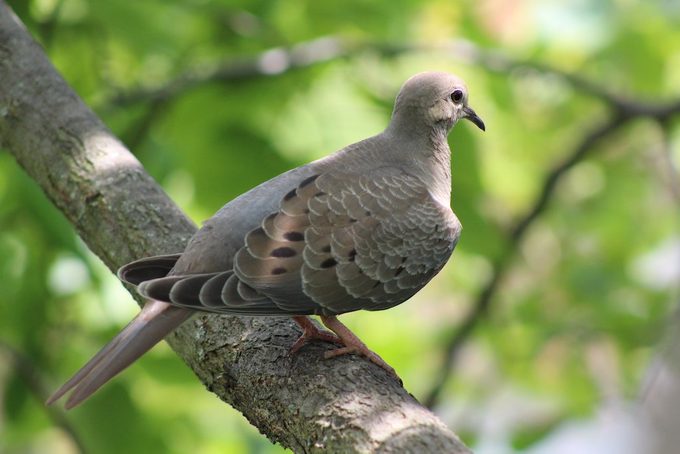 Courtesy Jeffrey Carter
Courtesy Jeffrey Carter What Does a Mourning Dove Look Like?
Both male and female mourning doves are known for their brown and gray coloring, black spots, small heads and slender tails. "They have that really amazing mix of muted tones, with beautiful defined black spots on their wings. You can sort of see an iridescence," says John Rowden, who is the senior director of bird-friendly communities at the National Audubon Society. They are 12 inches long with an 18 inch wingspan. Check out 15 breathtaking photos of mourning doves.
Mourning Dove vs. Eurasian Collared Dove
Mourning doves are sometimes confused with Eurasian collared doves or white-winged doves. If a thick black band is present on the collar, it's a collared dove. You can tell white-winged doves apart by their namesake white wing stripe.
What Does a Mourning Dove Call Sound Like?
Bird songs provided by the Cornell Lab of Ornithology.
Why do doves coo? The cooooOOOOO-woo-woo-woo call is almost always uttered by the male mourning dove, not the female. These distinctive mourning dove sounds are—wait for it—a wooing call, an enticement to a mate or potential mate. Many passionate backyard birders find the soft, distinctive cooing of this dove to be calming and utterly peaceful. "The birds vocalize quite a lot and that's where they get their name, because of their mournful call," says John Rowden.
Learn about the many sounds of hummingbirds.
 Courtesy David Judy Pinner
Courtesy David Judy Pinner
Unique Sleeping Position
When they sleep, their head rests between their shoulders, close to the body (they do not tuck their little heads under their shoulder feathers, like a lot of other birds do).
Where do birds sleep at night?
How Fast Do Mourning Doves Fly?
Their long, pointed wings are almost falcon-like in appearance, while their pointed tails are longer than those of any other doves. These "design features" enable the birds to fly fast. Mourning doves have been clocked at 55 mph!
Discover the fastest birds in North America.
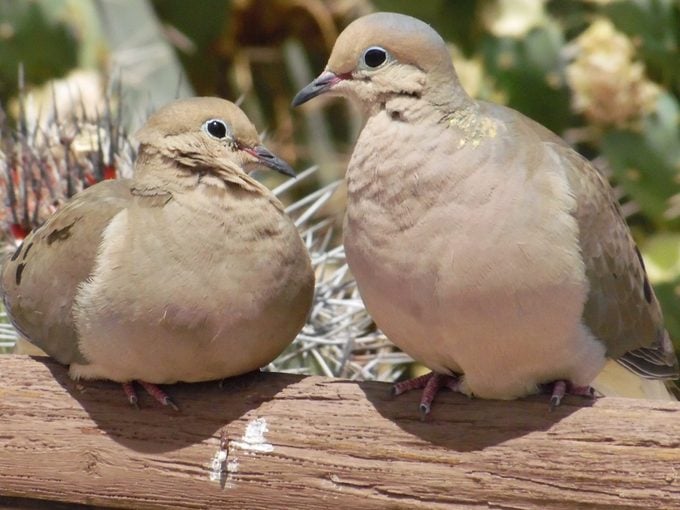 Courtesy Lisa Mason
Courtesy Lisa Mason
Mourning Doves Mate for Life
It's fairly common to see two mourning doves cuddling with each other. Mating pairs are monogamous and often mate for life. Another name for them is "turtle doves." So, small wonder that the author of the favorite Christmas song kept them as a pair. (Besides, "a mourning dove in a pear tree" just doesn't sound right!)
Two Eggs are Common in Mourning Dove Nests
When they lay eggs, it is almost always just two. (Singletons are rare, as are bigger clutches.) Incubation takes just two weeks. Learn more about mourning dove nests.
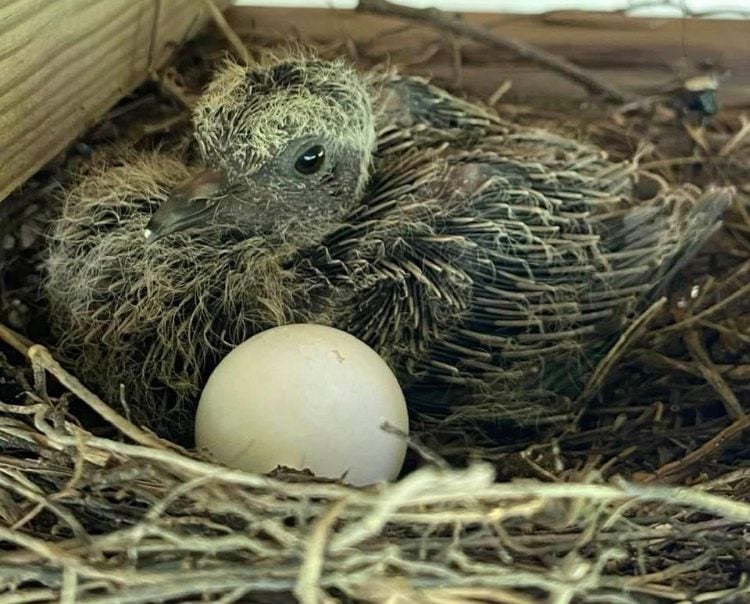 COURTESY AMY NICOSIA
COURTESY AMY NICOSIA These Birds Have Good Co-Parenting Skills
Males and females work together to feed their new babies something called "crop milk" or "pigeon milk" for the first few days of their life. Rich in protein and fat, it resembles cottage cheese, is secreted by the adults' crop lining, and is regurgitated to the little ones. Weaning is fast, though—by the fourth day of life, the diet starts to segue to seeds, and by two weeks, the youngsters are nearly fledged.
Here's everything you need to know about baby mourning doves.
Mourning Doves Have a Famous Ancestor
Mourning doves are in the pigeon family and are considered closely related to the late, lamented passenger pigeons.
Doves Are Hunted
These doves are still hunted as a game bird in many areas and are easy prey for outdoor cats. However, I haven't read any concerns about population decline. It's estimated that there are more than 100 million mourning doves.
 James Randklev/Getty Images
James Randklev/Getty Images Mourning Doves Have a Wide Range
You can spot mourning doves nearly anywhere—in cities, backyards and even the middle of the Mojave Desert. Mourning doves are commonly found in southern Canada, the contiguous United States and northern Mexico. They are mainly attracted to open spaces, only avoiding areas with deep forests. "Wherever you are, you might have a mourning dove in your area," John Rowden says. He adds that very few species are so common both geographically and seasonally.
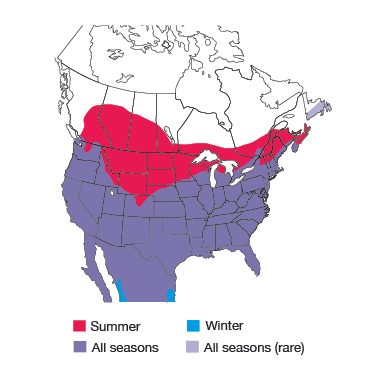 Range maps provided by Kaufman Field Guides, the official field guide of Birds & Blooms.
Range maps provided by Kaufman Field Guides, the official field guide of Birds & Blooms.
Check out 15 common backyard birds you should know.
Will Doves Come Back to Nest After Being Scared Off
Source: https://www.birdsandblooms.com/birding/attracting-birds/10-surprising-facts-about-mourning-doves/
0 Response to "Will Doves Come Back to Nest After Being Scared Off"
Post a Comment